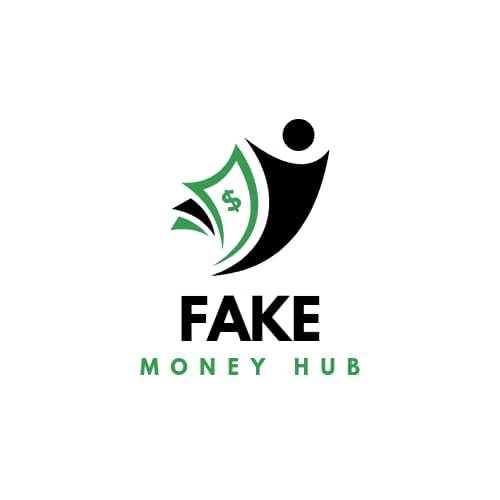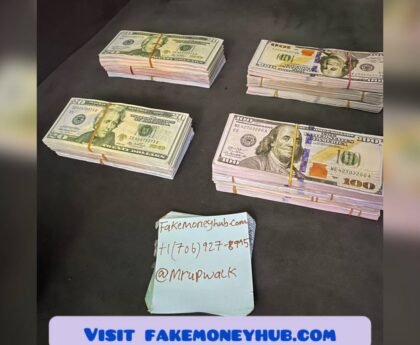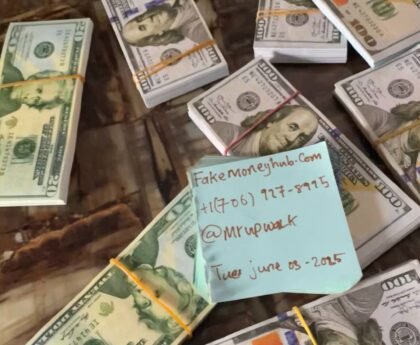Best Place To Buy Counterfeit Money Online | Fake Money For Sale
Counterfeit Money To Buy is as ancient as currency itself, evolving alongside advancements in financial systems. From the early days of trimming precious metals from coins to producing Counterfeit Banknotes with advanced printing technologies, counterfeiters have persistently sought methods to deceive.
This illicit practice has significantly influenced history, affecting economies, wars, and policies globally. From ancient forgeries in Lydia to the sophisticated operations of World War II, counterfeiting has served as both a tool of rebellion and greed.
Governments have countered with innovative security measures, creating a continuous struggle between counterfeiters and authorities.
In this article, we will explore the intriguing history of How To Buy Counterfeit Money, examining its origins, societal impacts, and the efforts to combat it.
Definition of Counterfeit Money
Counterfeit Money refers to the creation of imitation currency designed to deceive recipients and pass as genuine legal tender.
This practice includes counterfeit coins, Undetectable Fake Banknotes, and other currency forms, with the primary aim of defrauding individuals or institutions. Historically, counterfeiting has caused significant economic disruptions, such as devaluing legitimate money and undermining trust in financial systems. Additionally, it has been used as a strategic tool in warfare to destabilize enemy economies, as witnessed during the American Revolutionary War and World War II.
The term “counterfeit” derives from the Old French word contrefaire, meaning “to imitate,” and is rooted in Latin with contra (against) and facere (to make). This historical context highlights the illicit nature of creating something that opposes authenticity.
Throughout history, Buying Counterfeit Money has driven the development of complex security measures in currencies to protect economies and deter this enduring fraudulent activity.
A Complete History of Counterfeit Money
With a foundational understanding of the definition and origins of Undetectable Counterfeit Money, we now delve deeper into its comprehensive history.
Ancient Origins of Counterfeit Money
The practice of counterfeiting traces back to the advent of coinage in ancient Lydia around 600 B.C., where the first Western coins were minted. Fraudsters will shave the edges of coins made from precious metals such as gold and silver to collect and reuse the shavings while maintaining the appearance of a full-value coin. Another prevalent technique involved plating base-metal coins with a thin layer of precious metal to mimic genuine currency.
In the 5th century Byzantine Empire, Alexander the Barber became a notorious counterfeiter due to his exceptional skills in coin forgery. Remarkably, instead of punishing him, Emperor Justinian employ Alexander in the state’s finance department, demonstrating how authorities sometimes utilize the talents of counterfeiters. These early forgeries destabilized economies by diminishing the value of real money, prompting governments to introduce mint marks and intricate designs to combat counterfeiting.
Counterfeiting in the Medieval Period
The medieval period witnessed the widespread use of coins made from gold, silver, and copper, presenting both opportunities and challenges for counterfeiters. Techniques such as clipping, where small pieces were cut from coins, and creating entire forgeries from base metals became commonplace.
Governments imposed severe penalties to deter counterfeiters, including mutilation, imprisonment, and execution. For instance, King Henry I of England decreed that counterfeiters should have their right hands amputated. Authorities also frequently redesigned coins, incorporating intricate patterns and mint marks to make forgery more difficult.
Despite these measures, counterfeiting persisted due to the high circulation of coinage across Europe, Asia, and the Middle East, underscoring the ongoing challenge of maintaining monetary integrity.
The Emergence of Paper Money and Counterfeiting
In 1160, the Song dynasty in China introduced paper currency, marking a transformative moment in monetary history. This innovation presented new opportunities for counterfeiters. The Yuan and Ming dynasties continued the use of paper money, leading to stringent anti-counterfeiting measures, including severe penalties such as capital punishment, to mitigate its proliferation.
During the American Revolutionary War, Best Counterfeit Money was deployed as a tool of economic warfare. British forces circulated fake Continental Dollars to destabilize the nascent American economy, illustrating the strategic use of counterfeiting in conflicts.
By the 18th century, counterfeiting in Europe and America had reached concerning levels. In colonial America, counterfeiters posed a threat to economic stability, with early paper bills often inscribed with warnings like “To counterfeit is death.” Despite such deterrents, counterfeiting persisted, prompting frequent redesigns of paper currency.
Counterfeit Money To Buy | Where To Buy Counterfeit Money
Counterfeiting in the 19th Century
The 19th century witnessed a substantial increase in counterfeiting, spurred by the Industrial Revolution and technological progress. During the U.S. Civil War, nearly one-third of the currency in circulation was counterfeit, precipitating a financial crisis. Northern entities even produced Counterfeit Money Dollars to undermine the Southern economy.
In response to widespread counterfeiting, the U.S. Secret Service was established in 1865 within the Treasury Department, with a primary mandate to combat counterfeiters and safeguard the nation’s financial stability.
The use of high-quality printing presses by counterfeiters compelled governments to implement more sophisticated anti-counterfeiting measures, including advanced printing techniques and distinctive designs.
Advancements in Counterfeiting During the 20th Century
The 20th century saw notable advancements in counterfeiting methods. During World War II, Nazi Germany orchestrated “Operation Bernhard,” a large-scale initiative to produce Counterfeit British Pounds and American dollars to destabilize Allied economies. This operation involved highly skilled forgers and advanced techniques, resulting in counterfeits nearly indistinguishable from genuine currency.
In the post-war era, the advent of inkjet printers and digital technology made counterfeiting more accessible. In response, governments introduced enhanced security features, including watermarks, holograms, and color-shifting ink, to deter forgeries. Currency redesigns became increasingly frequent, reflecting the ongoing contest between counterfeiters and authorities.
Counterfeiting in the 21st Century
Modern technology has revolutionized counterfeiting, with high-resolution scanners, graphic design software, and 3D printers facilitating the production of highly detailed currency replicas. For example, a Canadian counterfeiting operation in 2011 produced over $1 million in Fake $20 Bills using advanced inkjet printers.
To address these challenges, governments have adopted polymer banknotes with advanced security features, such as transparent windows, holographic images, and micro text. Australia’s introduction of polymer notes in the 1980s set a benchmark for other nations, significantly reducing counterfeiting rates.
The future of counterfeiting is likely to involve emerging technologies such as artificial intelligence and 3D printing. Governments are investing heavily in research and development to stay ahead in this technological contest, ensuring the security and trustworthiness of currency.
This comprehensive overview of counterfeiting, from its inception to contemporary challenges, underscores the enduring importance of maintaining the integrity and trustworthiness of currency in the face of evolving threats.
How Does Modern Technology Influence Counterfeiting?
Modern technology has significantly impacted counterfeiting, making it more sophisticated and accessible. High-resolution scanners, graphic design software, and advanced inkjet printers enable counterfeiters to produce highly detailed currency replicas.
Digital tools have facilitated the replication of intricate designs, posing challenges for authorities. For instance, in 2011, a Canadian group used advanced printers to create over $1 million in Counterfeit $20 Bills, demonstrating the quality achievable through modern means.
In response, governments have implemented cutting-edge security features, such as holograms, color-shifting ink, and polymer notes with transparent windows and micro text. These measures are design to stay ahead of counterfeiters, who continue to use technological advancements, including artificial intelligence and 3D printing, to further refine their methods.
FAQs
Are there any notable examples of counterfeiting in history?
Indeed, throughout history, counterfeiting has been used strategically in conflicts, such as the American Revolutionary War and World War II, highlighting its potential impact on economies and societies.
What are some common security features used to prevent counterfeiting?
Standard security features include watermarks, holograms, color-shifting ink, micro text, polymer notes with transparent windows, and raised printing. However, counterfeiters persist in leveraging technology to create sophisticated replicas capable of bypassing these measures. Consequently, governments regularly update and enhance their security protocols.
How has the battle between authorities and counterfeiters evolved over time?
As technology has progressed, so have counterfeiting techniques. Governments and financial institutions continuously update security features and redesign currency to outpace counterfeiters. This technological arms race underscores the ongoing effort to maintain the integrity and trustworthiness of currency in an ever-evolving landscape.
In conclusion, the history of Counterfeit Money To Buy is long and complex, with technological advancements continuously challenging efforts to uphold monetary integrity.
From early coins to modern polymer banknotes, counterfeiters have adapted their methods to create convincing replicas that threaten economies globally. However, governments persist in investing in research and development to stay ahead of counterfeiters and safeguard the trustworthiness of currency.
As we transition to an increasingly digital world, the future of counterfeiting presents new challenges and opportunities for both criminals and authorities. It is crucial for societies to remain vigilant and ensure the security of their financial systems against this ongoing threat.
By understanding past and present trends in counterfeiting, we can better prepare for the future and maintain the integrity and trust in our currency systems.


